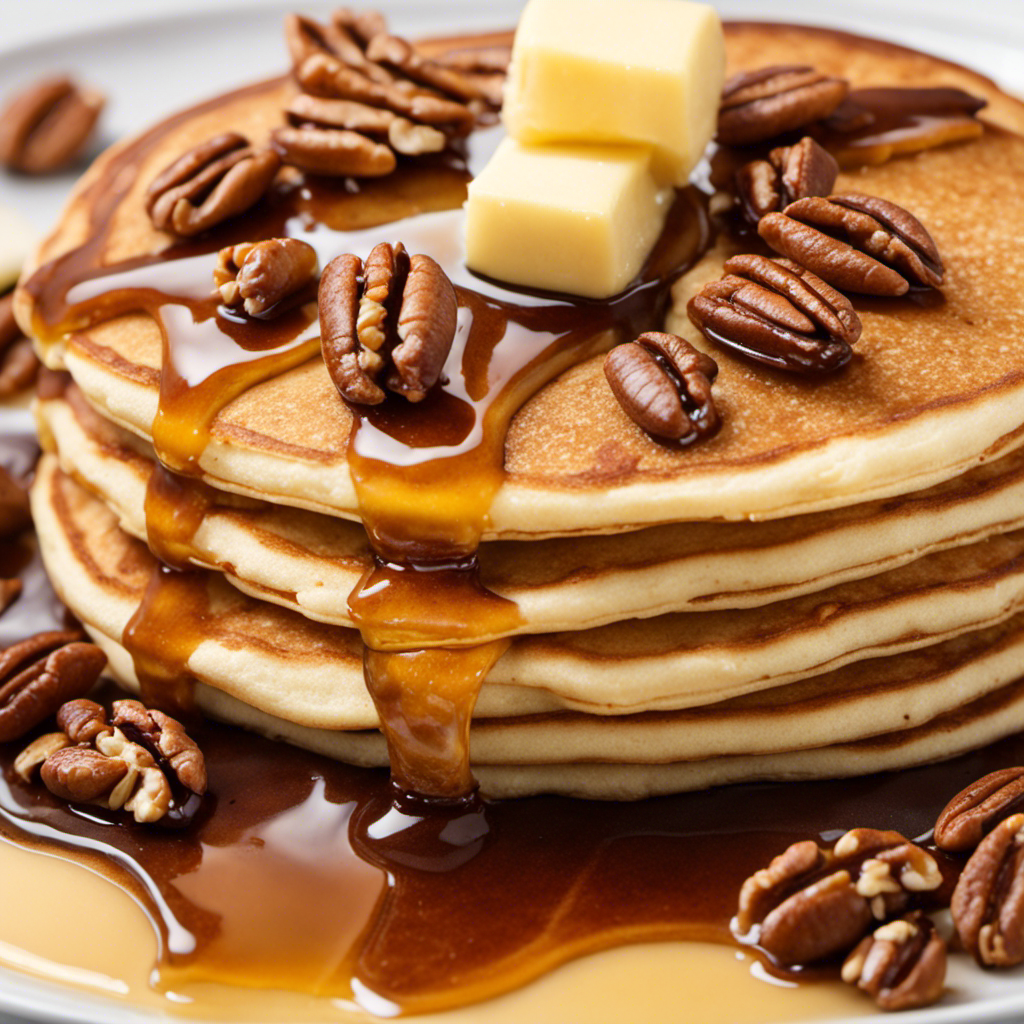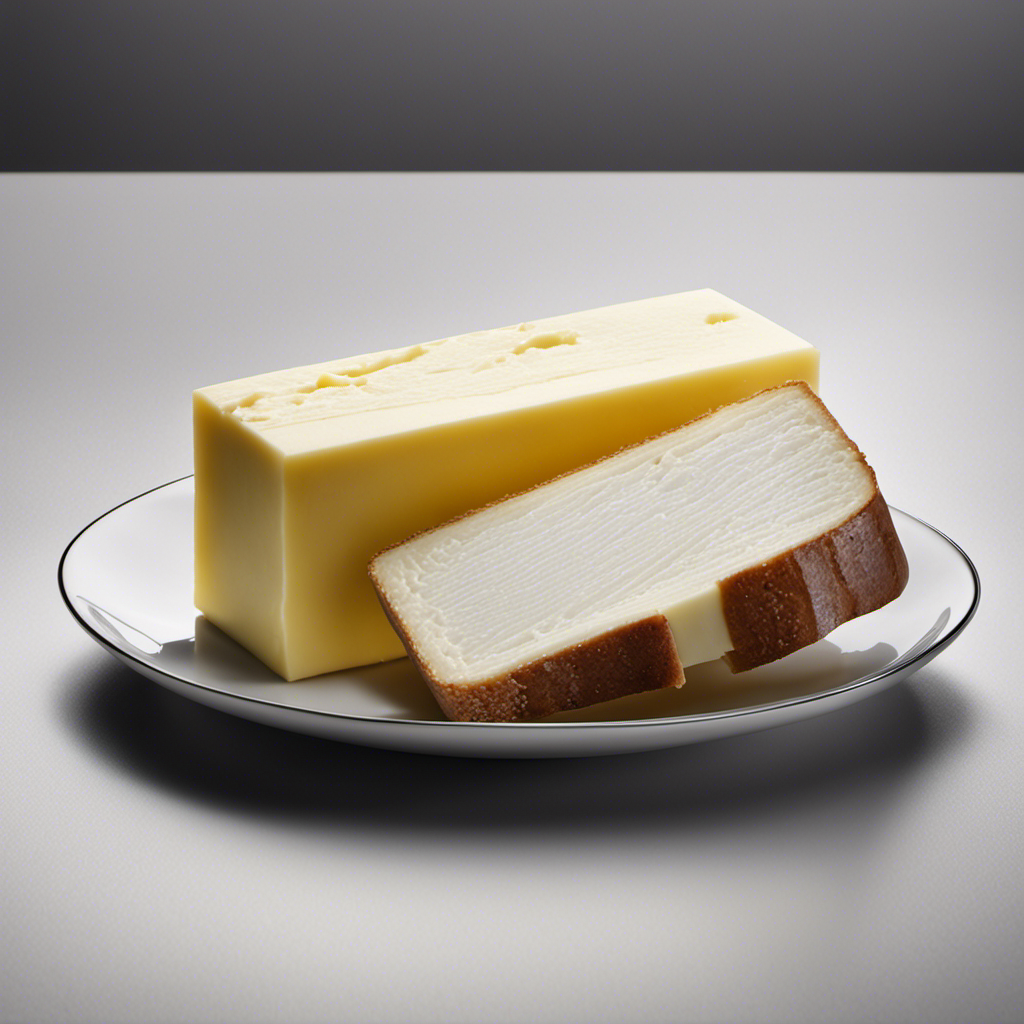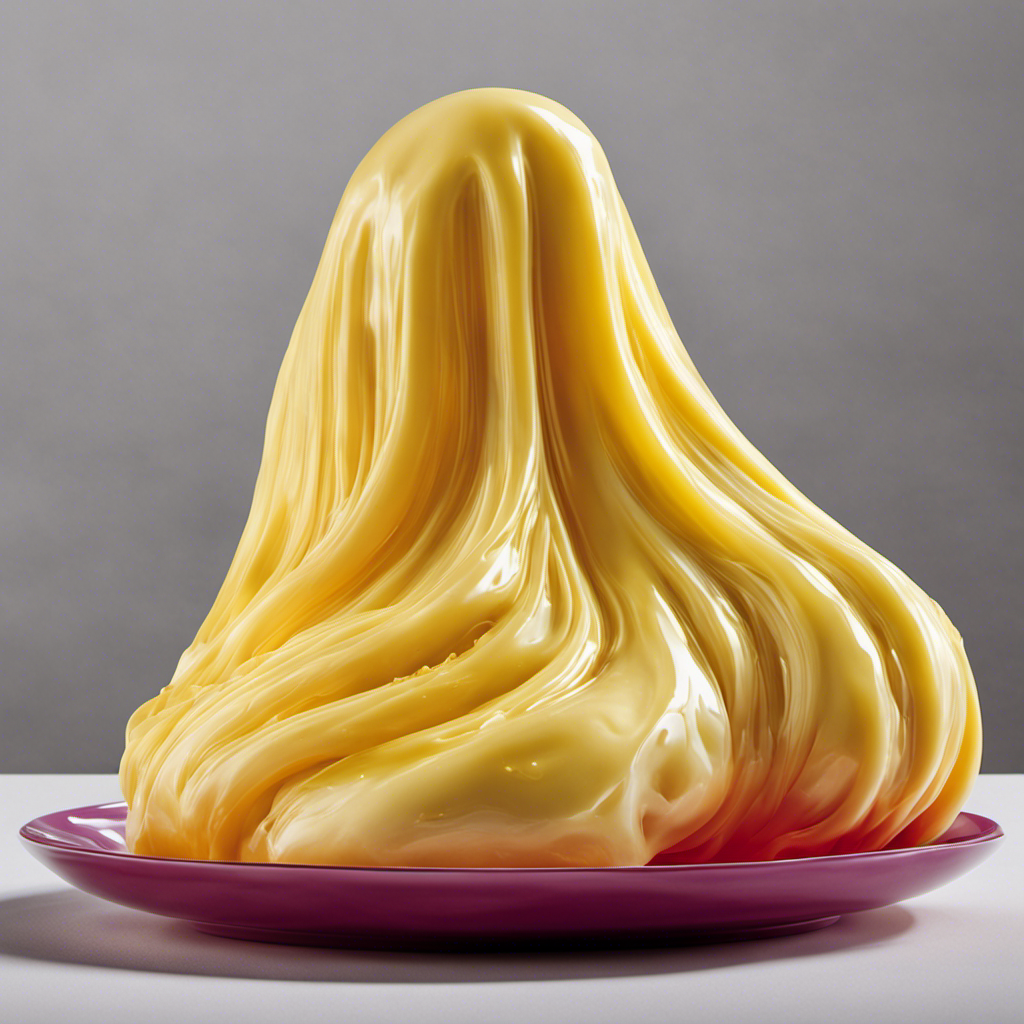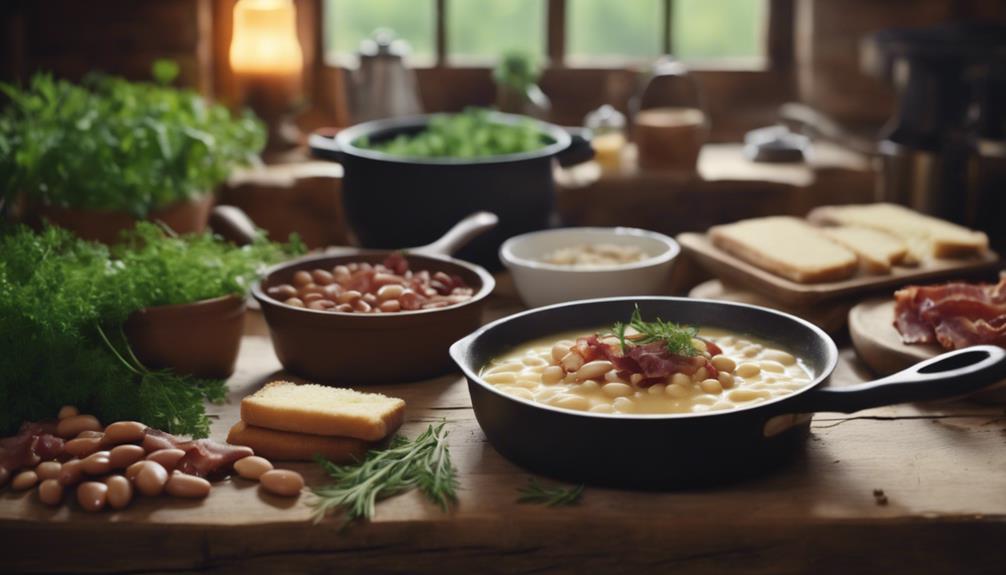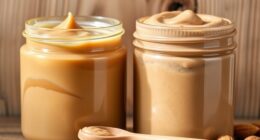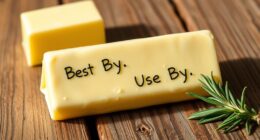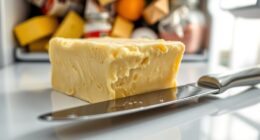I adore breakfast. It is the most crucial meal of the day, and there is nothing quite like beginning with a pile of light and fluffy pancakes topped with a generous drizzle of warm, buttery syrup.
But why settle for ordinary when you can have extraordinary? Introducing my secret recipe for homemade Butter Pecan Syrup. It’s a delectable blend of rich, nutty flavors that will take your breakfast to the next level.
Get ready to tantalize your taste buds and impress your brunch guests with this irresistible syrup.
Key Takeaways
- Toasting pecans in the oven enhances their flavor and adds crunch to the syrup.
- Infusion time and temperature are crucial for extracting flavors and achieving a smooth and flavorful infusion.
- High-quality butter greatly influences the richness and creaminess of the syrup.
- Proper storage is crucial for preserving the flavor and quality of the butter pecan syrup.
Gathering the Ingredients
Before you begin making the butter pecan syrup, make sure you’ve gathered all of the necessary ingredients.
Firstly, you’ll need to prepare the pecans. Start by roasting them in the oven for a few minutes until they become fragrant and slightly golden. Let them cool completely before chopping them into small pieces. This will give the syrup a delightful crunch and enhance the overall flavor.
Moving on to the butter, it’s crucial to choose the right one. Opt for unsalted butter as it allows you to control the saltiness of the syrup. Make sure the butter is at room temperature for easy mixing. Remember, the quality of the butter will greatly influence the richness and creaminess of your syrup. So, choose wisely!
Toasting the Pecans
As you toast the pecans, be sure to keep a close eye on them so they don’t burn. The process of toasting nuts is crucial in achieving that rich, nutty flavor infusion that will make your butter pecan syrup truly irresistible. The aroma that fills the kitchen as the nuts slowly turn golden brown is simply divine.
The crackling sound of the pecans as they heat up in the pan creates a sense of anticipation. The sight of the nuts transforming from pale to a deep, toasty brown is visually appealing. The warm, earthy scent that wafts through the air evokes a feeling of comfort and warmth.
Toasting the pecans not only enhances their flavor but also adds a delightful crunch to your syrup. So take your time, savor the process, and let the toasted nuts work their magic in your butter pecan syrup.
Making the Butter Infusion
When it comes to making the perfect butter infusion, there are a few key factors to consider.
First, the infusion time and temperature play a crucial role in extracting the rich flavors from the butter. Getting the timing and temperature just right can make all the difference in achieving a smooth and flavorful infusion.
Second, the quality of the butter you use is essential. Opting for a high-quality butter will result in a richer and more flavorful infusion.
Lastly, the quantity of butter used also matters. Finding the right balance between too much and too little butter will ensure that the infusion is not overpowering or lacking in flavor.
Infusion Time and Temperature
To properly infuse the butter pecan flavor into the syrup, you’ll want to let it steep for at least 30 minutes at a low temperature. This is crucial for achieving that rich, nutty taste that we all love. The key to successful infusion lies in temperature control. I recommend using a stove on the lowest heat setting or a slow cooker set to low. This gentle heat allows the butter and pecans to slowly release their flavors into the syrup, without burning or overpowering the mixture.
Now, let me share with you three important things to consider during the infusion process:
- Patience: Infusing syrup takes time, so be patient and let the flavors meld together gradually.
- Aroma: As the syrup simmers, a delightful aroma will fill your kitchen, creating a warm and inviting atmosphere.
- Customization: Don’t be afraid to experiment with different flavor variations. Add a touch of cinnamon or a splash of vanilla extract to enhance the butter pecan profile.
Butter Quality and Quantity
For the best results, remember that using high-quality butter and the right amount will greatly impact the overall taste and texture of your homemade concoction. The flavor of butter is crucial in creating a delicious butter pecan syrup. Opt for unsalted butter, as it allows you to control the saltiness of the syrup. Look for butter with a rich and creamy taste, as it will enhance the sweetness of the pecans. When melting the butter, be careful not to let it burn, as it can affect the flavor and create a bitter taste. Use a low heat setting and stir constantly until the butter is melted and golden brown. Remember, the quality of butter and the skillful melting process can elevate your butter pecan syrup to new heights of flavor.
| Butter Quality | Butter Quantity |
|---|---|
| High-quality | Right Amount |
| Rich and creamy | Control the saltiness |
| Melts evenly | Golden brown and not burnt |
| Enhances sweetness | Delicious butter flavor |
| No bitter taste | Perfect texture |
Preparing the Simple Syrup
When it comes to preparing the simple syrup for your butter pecan creation, there are a few key points you’ll want to keep in mind.
First, let’s talk about the ingredients you’ll need. You’ll typically find that simple syrup is made from just two ingredients: sugar and water.
The cooking time required can vary depending on the desired consistency, but a general rule of thumb is to simmer the mixture for about 10-15 minutes until the sugar has completely dissolved.
Once your syrup is ready, it’s important to store it properly to maintain its freshness. I recommend transferring it to a clean glass jar or bottle and keeping it in the refrigerator.
This will help extend its shelf life and ensure that you can enjoy your delicious butter pecan syrup for as long as possible.
Ingredients for Syrup
The ingredients you’ll need for the syrup are butter, pecans, brown sugar, heavy cream, and vanilla extract. Gathering these ingredients is the first step in creating a delectable butter pecan syrup that will elevate any dish.
As you gather the ingredients, you can already imagine the rich aroma of toasted pecans wafting through your kitchen. The anticipation builds, knowing that these simple ingredients will come together to create a creamy and nutty syrup that will tantalize your taste buds.
There’s something magical about toasting pecans, as the heat brings out their natural oils and intensifies their flavor. The crackling sound and the warm, nutty scent fill the air, creating a sense of warmth and comfort.
It’s a small act that adds depth and complexity to your syrup, making it truly irresistible.
Cooking Time Required
Once you’ve gathered all the ingredients, you’ll need to cook the syrup for a specific amount of time to achieve the perfect consistency and flavor. Cooking time is crucial in making butter pecan syrup, as it allows the flavors to meld together and creates a rich, velvety texture. The infusion techniques used during this process enhance the taste and aroma of the syrup, elevating it to a whole new level. To give you an idea of the cooking time required, refer to the table below:
| Cooking Time | Consistency | Flavor |
|---|---|---|
| 10 minutes | Thin | Mild |
| 20 minutes | Medium | Rich |
| 30 minutes | Thick | Intense |
Storage Recommendations for Syrup?
To maintain optimal quality, it’s important to store the syrup in an airtight container in the refrigerator. This will help prolong its shelf life and preserve its delicious flavor.
Here are some key tips for storing butter pecan syrup:
-
Keep it sealed: Make sure the container is tightly sealed to prevent air from entering and causing the syrup to spoil.
-
Store it upright: Storing the syrup upright helps prevent any leakage or spills that may occur if it’s stored on its side.
-
Keep it cool: The refrigerator is the best storage option for butter pecan syrup. The cool temperature helps maintain its freshness and prevents bacterial growth.
By following these storage recommendations, you can enjoy your butter pecan syrup for longer periods of time without compromising its quality.
Combining the Ingredients
After blending the butter and pecans, you’ll want to add the remaining ingredients to the mixture. This is where the magic really happens in creating that delicious butter pecan syrup.
There are a few cooking techniques you can use to bring out the best flavors in your syrup. One option is to gently simmer the mixture on low heat, allowing the flavors to meld together slowly. Another technique is to bring the mixture to a rolling boil, which will give the syrup a thicker consistency.
As for flavor variations, you can get creative and add a hint of vanilla extract for a sweet and aromatic twist. If you prefer a little kick, a dash of cinnamon or nutmeg can add a warm and spicy note. The possibilities are endless when it comes to customizing your butter pecan syrup to suit your taste buds.
Cooking the Syrup
While gently simmering or boiling the mixture, you can add flavor variations such as vanilla extract, cinnamon, or nutmeg to customize your delicious syrup.
The cooking techniques used in making butter pecan syrup are all about infusing the flavors together, creating a rich and aromatic blend.
As the syrup simmers, the fragrant scents of vanilla and cinnamon fill the air, creating a warm and inviting atmosphere.
The sweetness of the syrup melds with the subtle spiciness of the cinnamon, resulting in a tantalizing combination of flavors that will leave your taste buds begging for more.
The addition of nutmeg adds a hint of warmth and depth, elevating the syrup to a whole new level of deliciousness.
Once the cooking process is complete, it’s time to move on to the next step: straining and bottling the syrup.
Straining and Bottling the Syrup
Once the syrup has finished cooking, it’s time to strain and bottle it for future use.
The first step is to ensure that the bottles are properly sterilized to prevent any contamination. I like to use hot, soapy water to clean the bottles thoroughly, followed by a rinse with boiling water. This ensures that the syrup stays fresh and safe to consume for a longer period.
Once the bottles are sterilized, it’s time to strain the syrup to remove any impurities or chunks. I usually use a fine mesh strainer to achieve a smooth and consistent syrup. The syrup should have a thick yet pourable consistency, similar to honey.
Once strained, carefully pour the syrup into the sterilized bottles, leaving a little bit of space at the top. Seal the bottles tightly, and store them in a cool, dark place for future use.
Storing and Shelf Life
To ensure the syrup stays fresh and safe to consume for a longer period, it’s important to store the bottles in a cool, dark place. Proper storage is crucial for preserving the rich flavor and quality of butter pecan syrup.
Here are some storage options to keep your syrup fresh and delicious:
-
Refrigerator: Keep the syrup in the refrigerator to maintain its freshness and prevent spoilage. The cool temperature helps to preserve the flavor and consistency.
-
Pantry: If refrigeration is not possible, storing the syrup in a dark pantry is another option. Make sure the area is cool and away from direct sunlight to prevent heat damage.
-
Sealed Containers: Transfer the syrup into airtight containers to prevent air exposure and maintain its freshness. This will also prevent any unwanted odors or flavors from seeping in.
Serving and Enjoying the Syrup
When serving and enjoying the syrup, it’s important to consider portion sizes to avoid excessive sweetness.
Butter pecan syrup is a delightful treat that can add a burst of flavor to your pancakes, waffles, or ice cream.
To enhance your dining experience, here are some serving suggestions and flavor variations to try.
For a classic combination, drizzle the syrup over a stack of warm pancakes and top it off with a dollop of whipped cream and a sprinkle of chopped pecans.
If you’re feeling adventurous, mix the syrup with some cream cheese and spread it on a toasted bagel for a unique and delicious breakfast.
For flavor variations, you can add a dash of cinnamon or a hint of vanilla to the syrup to elevate the taste.
Frequently Asked Questions
Can I Use a Different Type of Nut Instead of Pecans for This Syrup?
Sure, you can use different nuts for the butter pecan syrup. There are plenty of alternatives to pecans, like walnuts or almonds, that would give a delicious flavor to your syrup. Experiment and find your favorite!
Can I Use Margarine Instead of Butter for the Butter Infusion?
Margarine vs. butter: which is better for baking? While margarine can be used as a substitute for butter, it may alter the flavor and texture. When infusing flavors into butter-based syrups, using real butter is recommended for a rich and authentic taste.
Can I Substitute the Sugar in the Simple Syrup With a Sugar Substitute?
Can I substitute the sugar in the simple syrup with a sugar substitute? While sugar substitutes offer benefits like lower calorie content, it’s crucial to consider the impact on taste and texture. Experimentation may be needed to achieve desired results.
How Long Can I Store the Syrup in the Refrigerator?
I store my homemade syrup in the refrigerator for up to two weeks. It’s important to use a clean, airtight container to extend the shelf life. Remember to give it a good shake before using!
Can I Use This Syrup as a Topping for Other Desserts Besides Ice Cream?
Yes, this syrup can be used as a topping for various desserts besides ice cream. It adds a delicious butter pecan flavor that can elevate the taste of cakes, pancakes, waffles, and more. Get creative with different flavors and enjoy!
Conclusion
And there you have it, a homemade butter pecan syrup that will take your breakfasts to the next level.
The combination of rich butter, toasted pecans, and sweet simple syrup creates a flavor explosion that will leave you wanting more.
As the saying goes, ‘good things come to those who wait,’ and the time and effort put into making this syrup will be well worth it when you taste the delicious results.
So go ahead, indulge in a little culinary adventure and treat yourself to the delectable goodness of butter pecan syrup.
Your pancakes and waffles will thank you!
